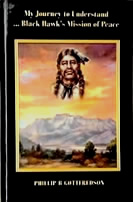Phillip B Gottfredson author/historian
The Black Hawk War Research Project, established in 1990, serves as a comprehensive resource on the history and personal narratives of the Black Hawk War in Utah. Under the direction of Phillip B Gottfredson, a historian and author, the website BlackhawkProductions.com presents over two decades of research focused on Utah's Native American history. The project prioritizes the documentation of the perspectives of Utah's Indigenous peoples, with particular attention to the Timpanogos Nation See Phillip B Gottfredson's Biography
**Historical Research:** Our mission is to deliver rich and informed insights into the Timpanogos Nation and its remarkable leaders. We explore the legendary lives of notable Timpanogos Chiefs, including Sanpitch, Wakara, Arapeen, Tabby, Ammon, Sowiette, Grospeen, and Antongua—better known as Black Hawk. Furthermore, we delve into the stories of other pivotal figures in the Utah Black Hawk War, such as Kanosh and Tintic. It is vital to recognize the profound and lasting impact of Brigham Young's Extermination Order No. 2 on the Timpanogos peoples.
**News and Updates:** Since 2003, BlackHawkProductions.com providing cutting-edge research and news on the Utah Black Hawk War legacy.
**Indigenous Perspectives:** At our core, we shine a spotlight on the perspectives of the Timpanogos Nation, highlighting the resilience and experiences shaped by settler colonialism.
**Education and Awareness:** This website serves as a crucial resource for those curious to learn about the Mormon's Utah Black Hawk War and to understand the profound historical significance of the Timpanogos Nation within the United States.
SOURCE MATERIAL:
CONSULTANTS:
Historian Will Bagley;
University of Utah Prof. Daniel McCool Ph.D.; University of Utah Prof. Dr. Floyd O'Neil Ph.D.; Historian Robert Carter; Mary Murdock Meyer Chief Executive of the Timpanogos Nation; Perry Murdock of the Timpanogos Nation Council; National
Forest Service Archeologist Charmain Thompson; Vanita Taveapont Director of Indian
Language Program Ute Tribe; Loya Arrum Ute Tribe; Shane Armstrong; Forrest Cuch Utah State Division of Indian Affairs; Filmmaker Larry
Cesspooch Ute Tribe of the Uintah Ouray Reservation. Marva Loy Egget Spring Lake, Utah; Author Norma Vance a direct descendant of David Monsen Paiute and the only known survivor of the Circleville Massacre.
RESOURCES:
The United States Department of the Interior; Timpanogos Nation; Commission of Indian Affairs Annual Report 1865, O.H. Irish; Powell; The Bureau of Indian Affairs; The Utah State Government Archives;
University of Utah Special Collections images by written permission; Brigham Young University
Special Collections; Salt Lake City Library; Mt. Pleasant Library; Cedar City Library Special Collections; Timpanogos Nation Uintah Valley Reservation; Navajo Nation; Northern Shoshone Nation; Private Journals
Mormon Pioneers; Ute Tribe of the Uinta Ouray Reservation - Uintah Valley Reservation.
Personal Interviews from 1989 to Present:
Personal Interviews of numerous descendants of early Utah Pioneers, and oral histories while living with members of various Native American Tribes throughout North and South America; Living descendants of Timpanogos Chiefs Wakara, Sowiette, Arapeen, Sanpitch, Ammon, Tabby, and Grospeen (all brothers), and Black Hawk (son of Sanpitch), Chief Executive Mary Murdock Meyer and members of the Timpanogos Nation Uintah Valley Reservation; Western Shoshone, Colorado Utes, Grandriver Ute, Uncompahgre Ute, Yampa Ute, Moache Ute, Wiminuche Ute, Ute Mountain Ute, and Navajo Dine'. Additional interviews with Hopi, Zuni, Pueblo, Apache, Shoshone, Arapaho, Lakota, Silets, Makah, Southern Paiute, Northern Paiute, Yrok, Anishinaabe, Cherokee, Choctaw, Inca, founding members of A.I.M., and Mayan of San Pedro Guatemala Jörge Stienwender, a keeper of the sacred Mayan Calenders.
RESEARCH MATERIAL:
Indian Depredations in Utah by Peter Gottfredson; Utah's Black Hawk War John Alton Peterson; American Indian Prophecies Kurt Kaltreider, Ph.D.; A History of Utah's American Indians Edited by Forest Cuch; Massacre at Mountain Meadows by Will Bagley; Book Of The Hopi by Frank Waters; Crazy Horse by Mari Sandoz; Writings of John D. Lee by Samuel Nyal Henrie; Life Among The Apaches by John C. Cremony 1850; For America To Live Europe Must Die - by Russell Means; Black Elk Speaks by John Neihardt; The Sacred Pipe by Joseph Epes Brown; The Paiutes of Pyramid Lake by Ruth Herman; Wisdom of the Elders by David Suzuki; I Will Fight No More Forever Chief Joseph; The Utes Must Go by Peter R. Decker; Red Twilight by Val FitzPatrick; 1491 Charles C. Mann, Pagans in the Promised Land by Steven Newcomb; Guns Germs Steel by Jared Diamond; Jacob Hamblin His Life in His Own Words; Massacre at Bear River by Rod Miller; Lore and Reminiscences of Participants, Carlton Culmsee; Schoolcraft; Bancroft; Founding of Fort Utah by Robert Carter; Shoshone Frontier Bear River by Brigham Madsen; Thunder Over the OCHOCO by Gayle ONTKO (5 vol. set); So Rugged and Mountainous by Will Bagley; The Shoshone Sentinels of the Rockies Virginia Cole Trenholm and Maurine Carley; The Book of Destiny Carlos Barrios- Mayan; Popol Vuh Dennis Tedlock; Walkara Hawk of the Mountains Paul Baily; Of Worthier Blood by Parker M. Nielson; Rolling Thunder by Doug Boyd; Claws of the Hawk Paul Baily ; Sacred Objects and Sacred Places by Andrew Gulliford; History of Salt Lake City. Tullidge's Histories, vol 1; Juan Rivera's Colorado, 1765 by author Steven G. Baker; Dominguez Escalante Journal: Their Expedition Through Colorado Utah Arizona and New Mexico in 1776 by Ted J. Warner; Standing Rock by Pamela Eakins; American Indian Myths and Legends by Erdoes and Ortez; The Storytelling Stone by Susan Feldmann; History of Payson by Norma Vance; The Dominguez - Escalante Journal Fray Angelico translation; Escalante's Dream: On the Trail of the Spanish Discovery of the Southwest by David Roberts; Chief Pocatello "The White Plume" by Brigham D. Madsen; Empire of the Summer Moon by S. C. Gwynne; Spanish Exploration In The Southwest 1542-1706 by Herbert Eugene Bolton, Ph.D.; North American Indians by Artist George Catlin Vol. 3.; Trail Across the Great Basin by James H. Simpson 1859; Antiquities of the Indians North and South America Peter Parley (1833);
